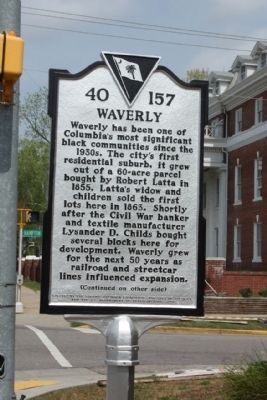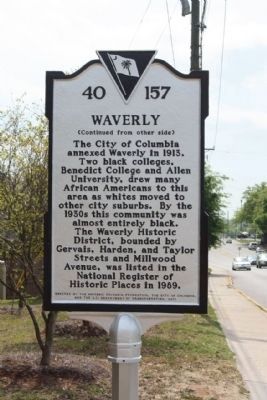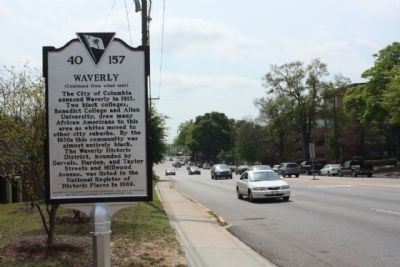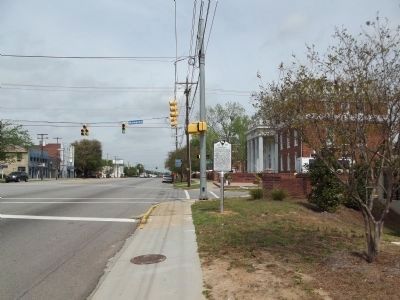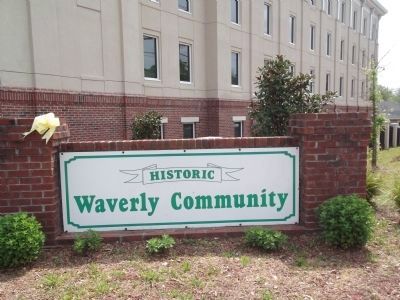Waverly in Columbia in Richland County, South Carolina — The American South (South Atlantic)
Waverly
Waverly has been one of Columbia’s most significant black communities since the 1930s. The city’s first residential suburb, it grew out of a 60-acre parcel bought by Robert Latta in 1855. Latta’s widow and children sold the first lots here in 1863. Shortly after the Civil War banker and textile manufacturer Lysander D. Childs bought several blocks here for development. Waverly grew for the next 50 years as railroad and streetcar lines encouraged growth.
(Reverse text)
The City of Columbia annexed Waverly in 1913. Two black colleges, Benedict College and Allen University, drew many African Americans to this area as whites moved to other city suburbs. By the 1930s this community was almost entirely black. The Waverly Historic District, bounded by Gervais, Harden, and Taylor Streets and Millwood Avenue, was listed in the National Register of Historic Places in 1989.
Erected 2012 by The Historic Columbia Foundation, the City of Columbia, and the S.C. Department of Transportatio,. (Marker Number 40-157.)
Topics and series. This historical marker is listed in these topic lists: African Americans • Education • Industry & Commerce. In addition, it is included in the Historically Black Colleges and Universities series list. A significant historical year for this entry is 1855.
Location. 34° 0.585′ N, 81° 1.238′ W. Marker is in Columbia, South Carolina, in Richland County. It is in Waverly. Marker is at the intersection of Harden Street and Hampton Street, on the right when traveling north on Harden Street. Touch for map. Marker is in this post office area: Columbia SC 29204, United States of America. Touch for directions.
Other nearby markers. At least 8 other markers are within walking distance of this marker. The Lighthouse & Informer / John H. McCray (about 300 feet away, measured in a direct line); Allen University (about 300 feet away); Carver Theatre (about 400 feet away); Black Churches Are Still Burning (about 400 feet away); Columbia Hospital "Negro Unit" / Columbia Hospital "Negro Nurses" (about 500 feet away); First Calvary Baptist Church (about 600 feet away); Good Samaritan-Waverly Hospital (about 600 feet away); Matilda A. Evans House (about 600 feet away). Touch for a list and map of all markers in Columbia.
More about this marker. Although Printed and casted as 2011, the marker was erected in 2012
Regarding Waverly. National Register Properties in South Carolina
Waverly Historic District (added 1989 - - #89002154)
♦ Historic Significance: Architecture/Engineering, Event
♦ Architect, builder, or engineer: Lankford,John Anderson, Wilson,Charles Coker
♦ Architectural Style: Late 19th And Early 20th Century American Movements, Late 19th And 20th Century Revivals
♦ Area of Significance: Education, Architecture, Black, Social History
♦ Period of Significance: 1925-1949, 1900-1924, 1875-1899
♦ Historic Function: Commerce/Trade, Domestic, Education, Health Care
♦ Current Function: Commerce/Trade, Domestic, Education, Health Care
The Waverly Historic District is significant as Columbia’s first suburb. The historic core of the Waverly neighborhood was originally an early subdivision of an antebellum plantation by the same name located on the outskirts of Columbia. By the early twentieth century, it had evolved into a community of African American artisans, professionals
and social reformers, many of whom made significant contributions to the social and political advancement of African Americans in Columbia and South Carolina. Originally a predominantly white neighborhood, Waverly’s development illustrates important patterns in the shift from biracial coexistence in the late nineteenth century to the practice of strict racial segregation common to early twentieth century urban centers. Waverly’s public institutions and other historic resources are also significant for their associations with individuals who played an active role in the Civil Rights Movement. The Waverly Historic District has a high concentration of vernacular residential, academic, and religious buildings reflecting a range of architectural characteristics of the late nineteenth and early
twentieth centuries. Representative styles and forms include Queen Anne, Four-Square, Craftsman, Bungalow,
Shotgun, Colonial Revival, and Neo-Classical. The majority of the 192 properties in the neighborhood, 137 of which are contributing, were built between ca. 1898 and ca. 1925. Listed in the National Register December 21, 1989.
(South Carolina Department of Archives and History)
Credits. This page was last revised on February 16, 2023. It was originally submitted on March 28, 2012, by Mike Stroud of Bluffton, South Carolina. This page has been viewed 779 times since then and 43 times this year. Photos: 1, 2, 3. submitted on March 28, 2012, by Mike Stroud of Bluffton, South Carolina. 4, 5. submitted on March 28, 2012, by Anna Inbody of Columbia, South Carolina.
